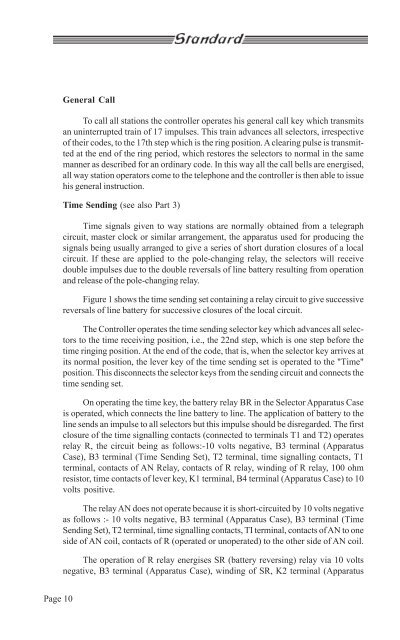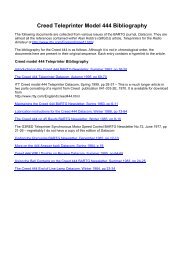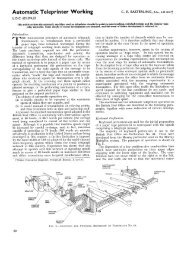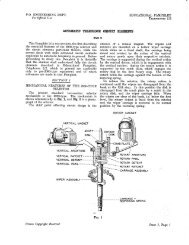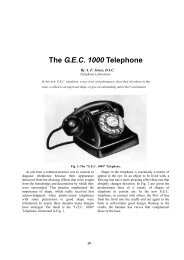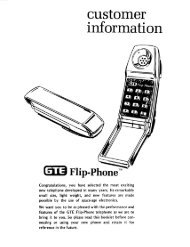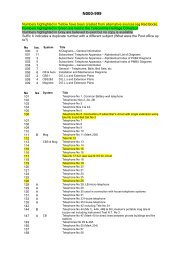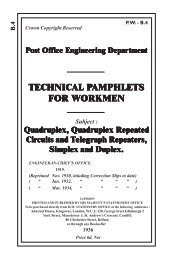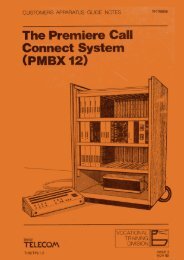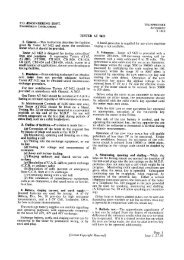TRAFFIC CONTROL TELEPHONE SYSTEMS Circuit - Sam Hallas
TRAFFIC CONTROL TELEPHONE SYSTEMS Circuit - Sam Hallas
TRAFFIC CONTROL TELEPHONE SYSTEMS Circuit - Sam Hallas
You also want an ePaper? Increase the reach of your titles
YUMPU automatically turns print PDFs into web optimized ePapers that Google loves.
Page 10<br />
General Call<br />
To call all stations the controller operates his general call key which transmits<br />
an uninterrupted train of 17 impulses. This train advances all selectors, irrespective<br />
of their codes, to the 17th step which is the ring position. A clearing pulse is transmitted<br />
at the end of the ring period, which restores the selectors to normal in the same<br />
manner as described for an ordinary code. In this way all the call bells are energised,<br />
all way station operators come to the telephone and the controller is then able to issue<br />
his general instruction.<br />
Time Sending (see also Part 3)<br />
Time signals given to way stations are normally obtained from a telegraph<br />
circuit, master clock or similar arrangement, the apparatus used for producing the<br />
signals being usually arranged to give a series of short duration closures of a local<br />
circuit. If these are applied to the pole-changing relay, the selectors will receive<br />
double impulses due to the double reversals of line battery resulting from operation<br />
and release of the pole-changing relay.<br />
Figure 1 shows the time sending set containing a relay circuit to give successive<br />
reversals of line battery for successive closures of the local circuit.<br />
The Controller operates the time sending selector key which advances all selectors<br />
to the time receiving position, i.e., the 22nd step, which is one step before the<br />
time ringing position. At the end of the code, that is, when the selector key arrives at<br />
its normal position, the lever key of the time sending set is operated to the "Time"<br />
position. This disconnects the selector keys from the sending circuit and connects the<br />
time sending set.<br />
On operating the time key, the battery relay BR in the Selector Apparatus Case<br />
is operated, which connects the line battery to line. The application of battery to the<br />
line sends an impulse to all selectors but this impulse should be disregarded. The first<br />
closure of the time signalling contacts (connected to terminals T1 and T2) operates<br />
relay R, the circuit being as follows:-10 volts negative, B3 terminal (Apparatus<br />
Case), B3 terminal (Time Sending Set), T2 terminal, time signalling contacts, T1<br />
terminal, contacts of AN Relay, contacts of R relay, winding of R relay, 100 ohm<br />
resistor, time contacts of lever key, K1 terminal, B4 terminal (Apparatus Case) to 10<br />
volts positive.<br />
The relay AN does not operate because it is short-circuited by 10 volts negative<br />
as follows :- 10 volts negative, B3 terminal (Apparatus Case), B3 terminal (Time<br />
Sending Set), T2 terminal, time signalling contacts, TI terminal, contacts of AN to one<br />
side of AN coil, contacts of R (operated or unoperated) to the other side of AN coil.<br />
The operation of R relay energises SR (battery reversing) relay via 10 volts<br />
negative, B3 terminal (Apparatus Case), winding of SR, K2 terminal (Apparatus


